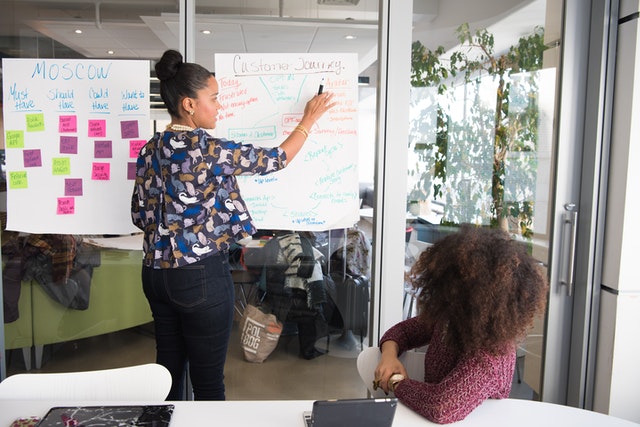With the term Transformation Catalyst I want to describe here a special type of transformation initiative. This initiative happens alongside a digital project. Often when digital agencies are asked to deliver a piece of digital solution, the client wants to learn as well more about Agile product development. If the agency is capable to provide consulting, coaching and training to enable the client, they can help the client in their transformation. The client and the agency will sign a contract that covers both, the delivery and the enablement services.
Quick-Wins & Co-Working
There are several advantages but also limitations in this model. One key advantage is, that together with the enablement, the delivery of the software is a quick win and a tangible result for client. Quick wins are important to any transformation initiative, because they fuel the transformation with energy (See also Kotter’s 8 Steps). Without tangible results every now and then, any transformation will loose its momentum and stop progressing.
Additionally to the quick win, the agency can also help to show how the new way of working feels like. Compared to a transformation that is only supported by training and coaching, this support is different. The hand-on working with experts, who already know how to do it, is a much more efficient method of learning. They agency experts can pair with the client’s people to show them how it works.
And then there is the effect, that when working with the agency people, their culture is influencing the client. They experience hands-on the paradigm shift in the collaboration. Some may also be inspired to become change agents and create a momentum for the client’s transformation. In order to make this work, the agency and the client people must work closely together.
Enablement Goal

What is important to make this type of service successful? The first thing to put the Transformation Catalyst on the right track is the clarification of the enablement goal. Running an Agile project within an traditional organisation will create a lot of conflicts. Does the client really want to change? How far reaching can these changes possibly proposed? Often the client is in an early stage of transformation and want to get first experiences.
Organisational redesign is usually not considered by the client as one of the consequences. They know that Agile is a culture change and want to see how that works. But to be as Agile as possible, the client should provide an environment that supports it. In the beginning of the project it’s often not foreseeable, how far-reaching the changes will be. For example, how restrictive processes on infrastructure prevent continuous delivery. This should be a point for the client to be open to adapt. It’s important to define a goal together with the client to later get the proper support when the project encounters these impediments.
Product Owner is not the Transformation Sponsor
Another important learning with this type of service is that the goals (delivery and enablement) have usually two different stakeholders. The individual at the client who is in charge of the product is usually not the one who is in charge of the transformation. Product Owners, product managers or program managers have the funding for the delivery. They are also interested in the concrete tangible results and the return of their investment.
Transformation on the other hand is targeted to the organisation. In focus are the people, their skills, the processes and policies. Product owners are interested in these things. But they are dependant on other stakeholders that shape the organisation. I have made good experiences in Transformation Catalysts, when the project has senior management support that is backing the transformational goals.
Training before you start

It can easily happen that the client does not have the time for training. In an traditional organisation, the people are fully utilized and usually have multiple projects – too busy to learn. That’s maybe a reason, why the client has chosen a more hands-on approach for transformation. But along the course of the project, client people will encounter problems. They are unable to see these problems early enough. Coaches on the project are sometimes not involved in all meetings and decisions to advise properly.
Although client people may have been on an agile training before, the service provider should not rely on it. Especially scaling topics and successful product ownership are something that needs to be learned in again. The hands-on approach to learn while the project gets delivered has a risk. Learning may come to late. It’s always good to learn from real experiences. When these experiences are actually major failures in a project delivery, the whole initiative may be at risk.
Enable methodology and strategy
A client is hiring an external partner for the delivery of a project usually because they don’t have the capacity and expertise. When the delivery project becomes an enablement initiative, the client wants to build up internal expertise. That expertise is around the new methodology. But also the digital business expertise is relevant. If a client wants to be self-sufficient in Agile, it’s seems to be quite clear, what they have to learn. In order to make the right decisions, it’s not just methodology that helps. It’s also experience from other digital businesses. Hence it should also be defined in the enablement goal, which additional expertise must be transferred to the client’s people. Then the enablement is not only a task for the Agile Coaches. Also the strategists, technologists or other experts need to enable the client.
Excellent delivery

One major precondition to run such a service is the high maturity in delivery practices of the delivery team. Only agencies are able to deliver such a service, that have the right teams. They must have a very good expertise in delivery practices. If the delivery of the project should be an example for the client’s organisation, the team should be excellent. They will be exposed to the eyes of the client in many events. Also the team building of such a team should already be done. So the team can perform from day one.
New Type of Client Relationship
Now we come to the question: Is this a new type of client relationship? Look at the in-sourcing trends. Cients are building up more and more delivery expertise on their own. It could mean that the era of traditional projects is over. Actually the reality is that digital initiatives become extremly complex. This complexity cannot be beaten with a traditional client-supplier relationship. With the Transformation Catalyst the service providers can reinvent themselves.